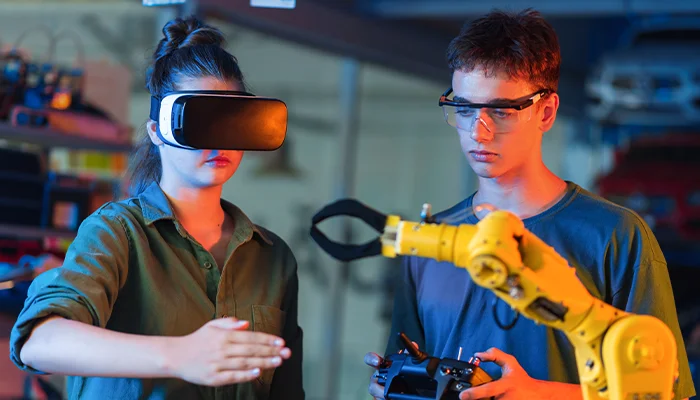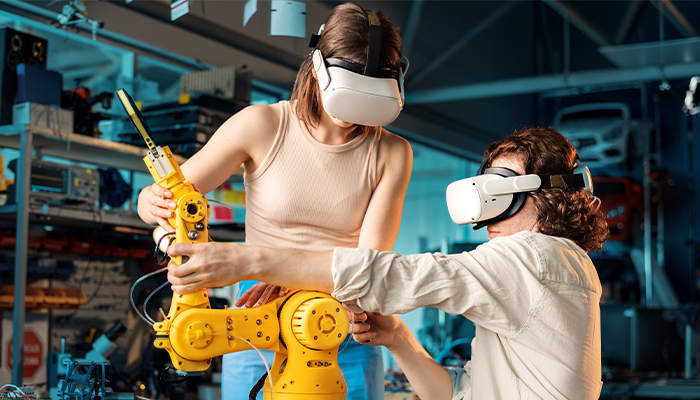AR VR in Aerospace: Use Cases and Benefits for the Aviation Industry

MAR, 14, 2024 17:19 PM
AR VR in Aerospace: Use Cases and Benefits for the Aviation Industry
It is no secret that the aerospace sector has been affected by the digital revolution of new technologies like AR and VR. These new technologies are truly game changers for airlines because they streamline their operations, ensure that they are properly training their employees, and provide superior service to their customers.
In this highly competitive field, airlines must stay up-to-date with the most recent demands of modern-day passengers.
AR VR in aerospace can allow companies to enhance their customers' flying experience and keep them engaged visually throughout their flight.
Furthermore, aviation companies can instruct cabin crew members, pilots, and ground crews and offer real-world learning experiences in a virtual setting, thus reducing the possibility of risk that flying poses. On this page, we'll be able to understand the significance of AR/VR within aerospace. We will also discuss the advantages of AR/VR in aerospace, and we will also explore its uses.
What is AR/VR in Aerospace?
AR/VR plays a crucial role in the aviation industry because it improves the efficiency of training programmes and is less expensive than traditional methods. Augmented reality in aviation uses it for training pilots, creating satellites, educating engineers, and providing remote maintenance support. AR is a new technology that incorporates virtual elements into the real world. Users can use these elements on tablets and smartphones.
In aviation, augmented reality provides the latest information on the weather as well as other aircraft and the terrain. Additionally, AR is helpful in the maintenance and repair of aircraft. AR serves as a reference for maintenance experts by providing live information and details to help them tackle complicated maintenance tasks.
However, VR immerses the user in a virtual world and provides an immersive experience for professional users and passengers.
VR technology has revolutionised aviation spaces, whether instructing pilots, examining aircraft, or providing a pleasurable passenger experience.
Training cabin crews is now easy. All they require are VR headsets and a joystick to experience an immersive learning experience, particularly for scenarios such as if a plane crashes and passengers are sick or if there is a hijacking.
Therefore, AR and VR technologies are a treasure trove for aviation because they provide a safe environment, educate your employees, and entertain passengers. There are a lot of airlines that make use of virtual reality technology to educate their employees.
One of these airlines, Boeing, is using virtual training to educate astronauts to increase their abilities and gain knowledge. All they require is a Varjo VR 2 headset to be able to interact with and see virtual aircraft, and they will experience the pressure that pilots go through when flying on an aircraft.
Benefits of AR in Aerospace
Manufacturing and designing aircraft is now easy
A plane flight is considered the most secure mode of transport. However, when flying involves the air, many safety concerns come up.
AR/VR technology used in aviation can enhance your manufacturing tasks. These technologies enable engineers to communicate with the virtual model of a plane.
Through the creation of virtual prototypes, designers and engineers can visualise the components of aircraft and identify issues in the design stage.
The integration of AR/VR technology into manufacturing processes facilitates the rapid installation of components, which reduces the time and effort required to make complicated assemblies.
Aids in-flight navigation
For aviation purposes, AR is not the latest technology, as it was initially employed for military use only.
The integration of AR/VR in aviation enables pilots to access real-time data to aid in locating, navigating, and accomplishing their tasks.
This allows the pilots to make the right decisions and provide a safe flight experience for passengers.
Make sure that aircraft maintenance is smooth and efficient
AR has brought about a significant change in the aviation industry, particularly in terms of safety.
The days of performing regular maintenance checks or reading manuals for users were lengthy tasks. In aviation, AR/VR lets commercial flight engineers have the ability to gain real-time insight through technologies like 3-D scanners and sensors. Additionally, they can inspect and repair parts of aircraft.
Reduce your time and money through AR training
Pilots must be knowledgeable about real-world flight conditions. In addition, AR enhances the efficiency of training by providing an experience for pilots as well as allowing them to train in virtual settings.
It is also difficult to offer on-the-job training for pilots because the airport is often packed. It takes a lot of time and resources to educate personnel, and even a small error can have an impact on the lives of individuals.
Benefits of VR in Aviation
Cost-effective
VR technology is affordable because the user just requires a headset and flight controls to experience a fully immersive experience.
If instructions are given using the traditional method, then it could increase maintenance and operational costs, such as higher use of fuel, wear and tear on aircraft, etc.
Therefore, pilots can prepare themselves for the future as VR technology trains them in a realistic setting.
Improves the experience of pilot training
Traditional training programmes are costly and only provide a limited opportunity for trainees to put their knowledge to the test. VR technology, on the other hand, accelerates the process of training. It also allows users to fully immerse themselves in learning programmes and assists them in becoming an improved workforce.
So, they can improve their flying skills and gain experience in various environments on different kinds of aircraft.
Creates a safe and secure space
While it is regarded as the most secure mode of travel, security is the most important thing in the aviation industry. If the staff is properly trained, it will reduce the chance of mistakes. A better education helps them recognise mistakes in the beginning and causes less damage to the person's life.
VR creates a safe and secure setting by providing an immersive virtual training experience for your employees. They can thus learn how to adapt to various situations, settings, and conditions to avoid accidents that could be fatal on the actual flight.
Applications (use instances) that use AR/VR for Aviation

In-flight entertainment for passengers
AR/VR technologies in aviation offer huge potential for airlines in that they can provide passengers with in-flight entertainment options.
These kinds of technologies can provide a soothing experience for people who aren't keen on flying because they allow them to be immersed in a virtual world. Many airline companies have invested in VR technology to engage their customers. They can play games that are interactive and have time-outs.
These experiences turn long flights into thrilling sessions. The airlines are encouraging customers to upgrade their economy class to business class and enjoy 360-degree video.
Aircraft guidance
Flying is the most secure method of travel and has a 1% out of 1 million chance of having a crash. However, most accidents happen in the takeoff or landing phases. AR technology offers real-time data for pilots on the terrain as well as weather, navigation, and more.
Aero Glass, for instance, utilises smart glasses to give pilots a 360-degree view of information without having to check multiple screens.
Maintenance of aircraft
Airline companies are using AR/VR in aviation to check and maintain aircraft with precision. They don't have to look for user guides. Through AR glasses, they can follow instructions while doing their job.
Maintenance of aircraft is made easier since the maintenance team can perform their duties more efficiently.
Ground crew training
Ground crew personnel are accountable for caring for your aircraft on the ground. Virtual reality training gives the ground staff hands-on training. It's used to speed up processes like marshalling aircraft, loading and unloading baggage, catering, and more. It assists ground personnel in becoming familiar with the aircraft as well as their surroundings.
AR/VR in aviation makes ramp handling procedures more efficient and ensures that there isn't any delay when departing. With the help of AR glasses, ground workers can complete their work safely by following the interactive guidelines displayed on the device.
Other Areas that Make Use of VR and AR
Repair and maintenance of aircraft can be extremely efficient due to the utilisation of VR and AR. By using VR and AR combined with other technology like 3D simulation, AI maintenance and repair teams can scan, analyse, and examine the aircraft with greater efficiency and with less effort.
In-flight entertainment and information systems may also undergo radical changes because of VR and AR technology. However, many passengers may experience discomfort or a sense of dread when using entertainment systems. With the advent of augmented reality flights as well as virtual reality flights, passengers are more absorbed in them and relish the experience. Additionally, with options like 360-degree movies, games, and shows that are in VR, passengers will be able to enjoy the experience more.
In the Final Words
Future developments in AR and VR in the aviation sector appear to be very exciting. AR/VR development services will help to achieve more efficiency in R&D maintenance and repair, innovation in product design and development, crew and staff inspection, as well as in-flight entertainment and infotainment technology.
Companies like PerfectionGeeks are providing diverse VR as well as AR options that provide these benefits and advantages to ensure safer, more cost-effective, and more effective VR and AR airlines.




Strategy
Design
Blockchain Solution
Development
Launching
Testing
Maintenance
Contact US!
India

Plot 378-379, Udyog Vihar Phase 4 Rd, near nokia building, Electronic City, Phase IV, Sector 19, Gurugram, Haryana 122015
Copyright © 2025 PerfectionGeeks Technologies | All Rights Reserved | Policy
Strategy
Design
Blockchain Solution
Development
Contact US!
India 
Plot 378-379, Udyog Vihar Phase 4 Rd, near nokia building, Electronic City, Phase IV, Sector 19, Gurugram, Haryana 122015
USA 
1968 S. Coast Hwy, Laguna Beach, CA 92651, United States
Copyright © 2025 PerfectionGeeks Technologies | All Rights Reserved | Policy
